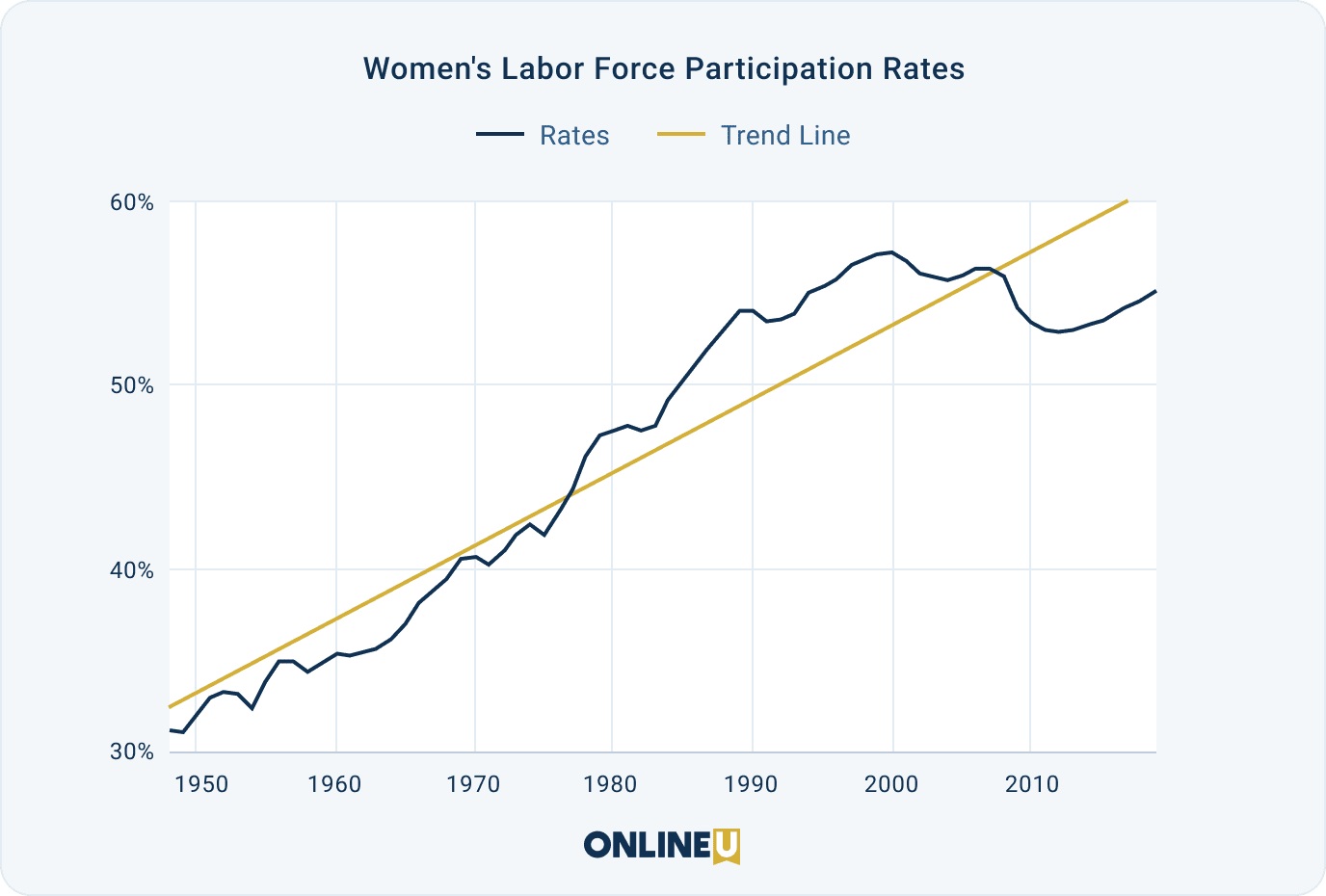Reversal of Roe Will Likely Slow Down Decades of Economic Empowerment for Women
Historical labor data and forward-looking econometric models suggest women’s economic power will likely deteriorate

Written By: Shadi Bushra
Published: 9/8/2022
Key Insights:
- BLS data shows women’s labor force participation increased faster than historical trends following the Supreme Court’s 1973 decision legalizing abortion nationwide.
- By the late 1980s, women’s labor force participation rate reached around 55%, where it would stay near until today; Men’s labor force participation today is closer to 65%.
- The historical data suggests that giving women more autonomy over when and whether to have children opened up economic opportunities.
- The positive effects of having abortion access were particularly beneficial for Black women in the workplace.
- Today, economists largely agree that more restrictive abortion laws will lead to fewer women in the workforce. Women will also work less often and for lower pay, with the brunt of these burdens falling on minority and low-income families.

Written By: Shadi Bushra
Published: 9/8/2022
Key Insights:
- BLS data shows women’s labor force participation increased faster than historical trends following the Supreme Court’s 1973 decision legalizing abortion nationwide.
- By the late 1980s, women’s labor force participation rate reached around 55%, where it would stay near until today; Men’s labor force participation today is closer to 65%.
- The historical data suggests that giving women more autonomy over when and whether to have children opened up economic opportunities.
- The positive effects of having abortion access were particularly beneficial for Black women in the workplace.
- Today, economists largely agree that more restrictive abortion laws will lead to fewer women in the workforce. Women will also work less often and for lower pay, with the brunt of these burdens falling on minority and low-income families.
Want an online degree that's:
- Affordable
- Popular
- Highly Rated
- Military-friendly
We've got them. Let's get started.

AD


ADVERTISEMENT
Online Programs You May Be Interested In
When the U.S. Supreme Court decided in Dobbs v. Jackson Women’s Health Clinic that there was no constitutional right to abortion, they overturned nearly a half-century of legal precedent.
This threatens the hard-won gains in women’s economic empowerment. Historical data shows that workplace equity and women’s labor force participation grew rapidly following the 1973 Roe v. Wade decision that legalized abortion to the point of fetal viability.
Economists and public health experts – using past data, current research, and the techniques of statistical inference – argue this was no historical coincidence. The fact that women could choose when or if to have children was causally related to these improvements, particularly in workforce participation and wage equality.
Women Saw Large Gains in Workforce Participation in Immediate Aftermath of Roe v. Wade
Women’s labor force participation was about 31% in 1948, compared to nearly 84% for men, a 53 percentage point difference between genders.
Twenty-seven years later, in 1975, women’s participation rate was still only 42%, a mere 11 percentage point gain over more than a quarter century.
After that, growth in women’s labor force participation accelerated until the rate reached 54% by 1989.
Unfortunately, the needle has not moved much in the following three decades: Women’s labor force participation rate in 2019 was 55%.
This historical data suggests that much of those gains in women’s workforce participation were locked in during the 15 years immediately after the Roe v. Wade decision.

It’s clear that women’s labor force participation was growing steadily from the post-war period on. But from about 1976 onwards, this trend accelerated to where the actual participation rate beat out the historical trend, often by significant margins.
By the late 1980s, women’s participation rate had reached the mid- to high- 50s. But today, decades after Roe, that participation rate has failed to break 60%. This is in line with the historical trend of women’s participation trailing men’s participation rate, which has never dropped below 60% and spent many years in the 70s and 80s.
This provides some evidence that Roe – and the push towards greater women’s rights that preceded and followed it – contributed to greater women’s participation in the workforce.
However, this does not prove the causality between the Supreme Court’s landmark decision and what we have seen in the labor data historically, or what we can expect to see in the future. That requires more advanced economic analysis, which we will examine next.
Causality Between Abortion Access and Economic Empowerment
“There’s no question that legal abortion makes it possible for women in all classes and races to have some control over their economic lives and ability to work outside the home,” Rosalind Petchesky, whose research was cited in the Supreme Court’s 1992 ruling in the case Planned Parenthood v. Casey, which reaffirmed Roe, said to the about how we make money. "> ADVERTISEMENT
Start Your UUֱ�� Search:
Review schools that align with your career aspirations.


